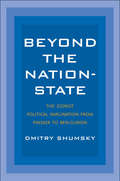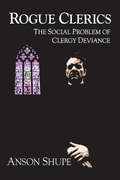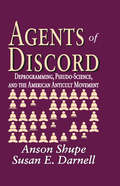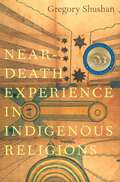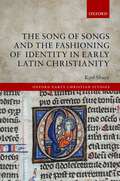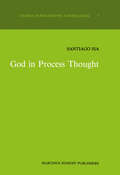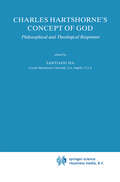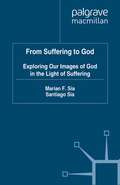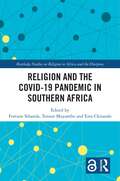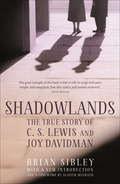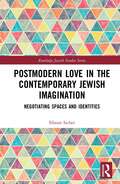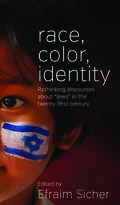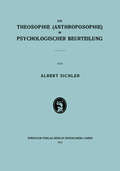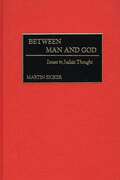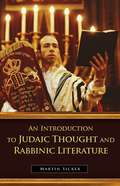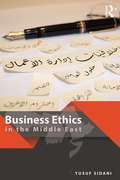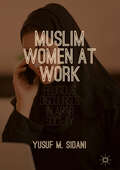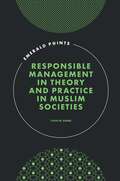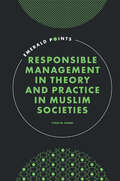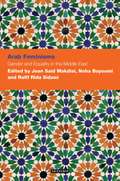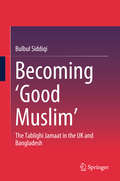- Table View
- List View
Beyond the Nation-State: The Zionist Political Imagination from Pinsker to Ben-Gurion
by Dmitry ShumskyA revisionist account of Zionist history, challenging the inevitability of a one-state solution, from a bold, path-breaking young scholar The Jewish nation-state has often been thought of as Zionism’s end goal. In this bracing history of the idea of the Jewish state in modern Zionism, from its beginnings in the late nineteenth century until the establishment of the state of Israel, Dmitry Shumsky challenges this deeply rooted assumption. In doing so, he complicates the narrative of the Zionist quest for full sovereignty, provocatively showing how and why the leaders of the prestate Zionist movement imagined, articulated, and promoted theories of self-determination in Palestine either as part of a multinational Ottoman state (1882–1917), or in the framework of multinational democracy. In particular, Shumsky focuses on the writings and policies of five key Zionist leaders from the Habsburg and Russian empires in central and eastern Europe in the late nineteenth and early twentieth centuries—Leon Pinsker, Theodor Herzl, Ahad Ha’am, Vladimir Ze’ev Jabotinsky, and David Ben-Gurion—to offer a very pointed critique of Zionist historiography.
Rogue Clerics: The Social Problem of Clergy Deviance
by Anson ShupeDuring the past several years the mass media in the United States has been awash with reports of priestly pedophilia, ecclesiastical cover-up, and clerical intimidation or financial settlements intended to silence victims. Based on journalistic accounts, or scholarly research, it might be assumed that this is a recent phenomenon. Journalist reports began only within the past few years. Similarly, most sociologists of religion and particularly specialists in deviance and criminology did not reflect awareness of clerical misbehavior in their work. Despite this, Anson Shupe shows that clergy deviance, whether it is sexual or otherwise, is not merely a recent problem. It is as old as the church itself and is inevitably bound to recur due to the nature of religious groups. This comprehensive analysis offers the first up-to-date analysis of sexual, economic, and authoritative clergy malfeasance across faiths and denominational authority structures. Drawing on examples taken from antiquity up until the present day, and using reports by historians, theologians, church spokespersons, therapists, social scientists, and journalists, Shupe critically evaluates clergy deviant behavior, dividing it into various types. He also makes use of the therapeutic literature, addressing victimization at the level of the individual, church, and community at large. In this way, he compares the response of the clergy to victims' attempts to mobilize movements calling for church reform. Perhaps most controversial, this book considers the possible relationship of homosexuality in the clergy to the occurrences of scandals in all religious traditions across the board. As an overview of clergy misconduct, this book is singular. There is simply no other comprehensive serious examination of this subject. Written by a sociologist for a wide range of readers, its multi-disciplinary nature, vivid examples, and wealth of research, will make the volume of interest to sociologists of religion and crime, historians and theologians, as well as a general public.
Rogue Clerics: The Social Problem of Clergy Deviance
by Anson ShupeDuring the past several years the mass media in the United States has been awash with reports of priestly pedophilia, ecclesiastical cover-up, and clerical intimidation or financial settlements intended to silence victims. Based on journalistic accounts, or scholarly research, it might be assumed that this is a recent phenomenon. Journalist reports began only within the past few years. Similarly, most sociologists of religion and particularly specialists in deviance and criminology did not reflect awareness of clerical misbehavior in their work. Despite this, Anson Shupe shows that clergy deviance, whether it is sexual or otherwise, is not merely a recent problem. It is as old as the church itself and is inevitably bound to recur due to the nature of religious groups. This comprehensive analysis offers the first up-to-date analysis of sexual, economic, and authoritative clergy malfeasance across faiths and denominational authority structures. Drawing on examples taken from antiquity up until the present day, and using reports by historians, theologians, church spokespersons, therapists, social scientists, and journalists, Shupe critically evaluates clergy deviant behavior, dividing it into various types. He also makes use of the therapeutic literature, addressing victimization at the level of the individual, church, and community at large. In this way, he compares the response of the clergy to victims' attempts to mobilize movements calling for church reform. Perhaps most controversial, this book considers the possible relationship of homosexuality in the clergy to the occurrences of scandals in all religious traditions across the board. As an overview of clergy misconduct, this book is singular. There is simply no other comprehensive serious examination of this subject. Written by a sociologist for a wide range of readers, its multi-disciplinary nature, vivid examples, and wealth of research, will make the volume of interest to sociologists of religion and crime, historians and theologians, as well as a general public.
Agents of Discord: Deprogramming, Pseudo-Science, and the American Anticult Movement
by Anson Shupe Susan E. Darnell"It is widely acknowledged that the United States has always provided fertile ground for the growth of new religious movements and cults, but modern organized efforts to oppose and restrict them have been less well understood. In Agents of Discord, Anson Shupe and Susan E. Darnell offer a groundbreaking analysis of the operations and motives of these oppositional groups, which they generally group under the umbrella term of the anticult movement.Historically there have always been parallel groups opposed to certain religious movements, whether these be anti-Quaker, anti-Roman Catholic, or anti-Mormon. The authors establish the cultural context of such movements in the nineteenth century. They point out the link between modern anticult movements and nativist movements in American history. Turning to the postwar era, the authors discuss the rise of anticult movements and focus specifically on one of the most prominent, the Cult Awareness Network (CAN). CAN was a two-tiered organization. Partly composed of volunteers, donors, and families affected by cult movements, it also included what the authors call an ""inner sanctum"" of behavioral science professionals, attorneys, and deprogrammers. Using never-before-reported data on CAN's activities, the authors cite an extensive history of financial impropriety that finally led to the organization's bankruptcy. They offer a pointed critique, informed by current scholarship, of the ""brainwashing"" model of mental enslavement presented by the anticult movement that has been a central assumption undergirding its activities. At the same time, they show how increasing professionalization has gradually begun a shift of such movements to a therapeutic model of exit counseling that rejects the crude methods of earlier intervention strategies.In their analysis of the anticult movement nationally and internationally, Shupe and Darnell merge sociological concepts and social history to make unique sense of a hereto"
Near-Death Experience in Indigenous Religions
by Gregory ShushanNear-death experiences are known around the world and throughout human history. They are sometimes reported by individuals who have revived from a period of clinical death or near-death and they typically feature sensations of leaving the body, entering and emerging from darkness, meeting deceased friends and relatives, encountering beings of light, judgment of one's earthly life, feelings of oneness, and reaching barriers, only to return to the body. Those who have NDEs almost invariably understand them as having profound spiritual or religious significance. In this book, Gregory Shushan explores the relationship between NDEs, shamanism, and beliefs about the afterlife in traditional indigenous societies in Africa, North America, and Oceania. Drawing on historical accounts of the earliest encounters with explorers, missionaries, and ethnologists, this study addresses questions such as: Do ideas about the afterlife commonly originate in NDEs? What role does culture play in how people experience and interpret NDEs? How can we account for cross-cultural similarities and differences between afterlife beliefs? Though NDEs are universal, Shushan shows that how they are actually experienced and interpreted varies by region and culture. In North America, they were commonly valorized, and attempts were made to replicate them through shamanic rituals. In Africa, however, they were largely considered aberrational events with links to possession or sorcery. In Oceania, Micronesia corresponded more to the African model, while Australia had a greater focus on afterlife journey shamanism, and Polynesia and Melanesia showed an almost casual acceptance of the phenomenon as reflected in numerous myths, legends, and historical accounts. This study examines the continuum of similarities and differences between NDEs, shamanism, and afterlife beliefs in dozens of cultures throughout these regions. In the process, it makes a valuable contribution to our knowledge about the origins of afterlife beliefs around the world and the significance of related experiences in human history.
Near-Death Experience in Indigenous Religions
by Gregory ShushanNear-death experiences are known around the world and throughout human history. They are sometimes reported by individuals who have revived from a period of clinical death or near-death and they typically feature sensations of leaving the body, entering and emerging from darkness, meeting deceased friends and relatives, encountering beings of light, judgment of one's earthly life, feelings of oneness, and reaching barriers, only to return to the body. Those who have NDEs almost invariably understand them as having profound spiritual or religious significance. In this book, Gregory Shushan explores the relationship between NDEs, shamanism, and beliefs about the afterlife in traditional indigenous societies in Africa, North America, and Oceania. Drawing on historical accounts of the earliest encounters with explorers, missionaries, and ethnologists, this study addresses questions such as: Do ideas about the afterlife commonly originate in NDEs? What role does culture play in how people experience and interpret NDEs? How can we account for cross-cultural similarities and differences between afterlife beliefs? Though NDEs are universal, Shushan shows that how they are actually experienced and interpreted varies by region and culture. In North America, they were commonly valorized, and attempts were made to replicate them through shamanic rituals. In Africa, however, they were largely considered aberrational events with links to possession or sorcery. In Oceania, Micronesia corresponded more to the African model, while Australia had a greater focus on afterlife journey shamanism, and Polynesia and Melanesia showed an almost casual acceptance of the phenomenon as reflected in numerous myths, legends, and historical accounts. This study examines the continuum of similarities and differences between NDEs, shamanism, and afterlife beliefs in dozens of cultures throughout these regions. In the process, it makes a valuable contribution to our knowledge about the origins of afterlife beliefs around the world and the significance of related experiences in human history.
The Song of Songs and the Fashioning of Identity in Early Latin Christianity (Oxford Early Christian Studies)
by Karl ShuveIn this work, Karl Shuve provides a new account of how the Song of Songs became one of the most popular biblical texts in medieval Western Christianity, through a close and detailed study of its interpretation by late antique Latin theologians. It has often been presumed that early Latin writers exercised little influence on the medieval interpretation of the poem, since there are so few extant commentaries from the period. But this is to overlook the hundreds of citations of and allusions to the Song in the writings of influential figures such as Cyprian, Ambrose, Jerome, and Augustine as well as the lesser-known theologian Gregory of Elvira. Through a comprehensive analysis of these citations and allusions, Shuve argues that contrary to the expectations of many modern scholars, the Song of Songs was not a problematic text for early Christian theologians, but was a resource that they mined as they debated the nature of the church and of the virtuous life. The first part of the volume considers the use of the Song in the churches of Roman Africa and Spain, where bishops and theologians focused on images of enclosure and purity invoked in the poem. In the second part, the focus is late fourth-century Italy, where a new ascetic interpretation, concerned particularly with women's piety, began to emerge. This erotic poem gradually became embedded in the discursive traditions of Latin Late Antiquity, which were bequeathed to the Christian communities of early medieval Europe.
God in Process Thought: A Study in Charles Hartshorne’s Concept of God (Studies in Philosophy and Religion #7)
by S. SiaOne of the controversial issQes which have recently come into prominence among philosophers and theologians is how one should understand the term l God. It seems that, despite the fact that a certain idea of God is assumed by not most, people, there is a degree of disagreement over the meaning many, if of the term. "God" is generally taken to refer to a supreme Being, the Creator, who is perfect and self-existent, holy, personal and loving. This understanding of "God" corresponds to what many have either been brought up to believe in or have come to accept as the meaning of this word. Neverthe less, theists appear to be defending a particular idea of God and to be accusing atheists of attacking another, one which does not tie in with the theistic interpretation. Cardinal Maximos IV, for instance, is quoted as saying, "The God the atheists don't believe in is a God I don't believe in either. "2 On the other hand, atheists have been challenging believers to explain clearly what they mean by "God" because these critics cannot see how that idea can have any acceptable meaning. Furthermore, theists them selves seem to be divided over the issue. H. P. Owen in his book Concepts of Deity shows quite convincingly that there is "a bewildering variety of concepts of God" among theists. ' One has only to ask around for confirma tion of this observation.
Charles Hartshorne's Concept of God: Philosophical and Theological Responses (Studies in Philosophy and Religion #12)
by Santiago SiaCharles Hartshorne's considerable writings have been influential in contem 1 porary religious and philosophical thought. Not only is he regarded as the leading living representative of process thought as well as a much respected interpreter of Whitehead, but he has also established himself as an original 2 and creative thinker in his own right. The literature on his philosophy has been rapidly increasing. His thought and influence have also been the subject 3 of a number of conferences and gatherings of scholars. One of Hartshorne's most notable contributions to contemporary philoso 4 phy and theology is his concept of God. In his writings he has set out "to formulate the idea of deity so as to preserve, perhaps increase, its religious value, while yet avoiding the contradictions which seem inseparable from the 5 idea as customarily defined." The result of his efforts has been the develop ment of the concept of a "dipolar God" (insofar as contrasting metaphysical predicates, e.g. relative/absolute, contingent/necessary, finite/infinite and so on, are affirmed as applicable to God although always in an eminent way). Inasmuch as he has elaborated this concept in close dialogue with classical theism, he also refers to it as "neo-classical". Because of the emphasis he places on the reality of change and becoming in his metaphysics (which regards God as the chief exemplification of metaphysical principles), the term 6 "process" has likewise been used to describe his notion of God.
From Suffering to God: Exploring our Images of God in the Light of Suffering
by Santiago Sia'A splendid book! The authors give a moving account of a tragic aspect of our present human world. It is a scholarly, learned account.' - Charles Hartshorne, Professor Emeritus of Philosophy, University of Texas at Austin Does the reality of suffering disclose anything about God's nature? The authors address this fundamental question by reflecting on some theistic responses to the challenge of suffering. Taking seriously the persistence of theistic belief despite widespread suffering, they focus on the practical ways some believers deal with suffering: by 'suffering with those in affliction' and 'working for the liberation of those who are opposed.' They then investigate the possibility of describing God as 'co-sufferer' and 'liberator.' In their exploration they turn to literature, theology and philosophy and offer an interesting interpretation of the relationship between these disciplines. Part I contains literary and descriptive reflections on the experiences of certain theists faced with the reality of suffering. The authors present and analyse the concerns, fears and hopes expressed in the book of Job and selected poems by Hopkins, Vaughan, Donne and Herbert. They then try to show that an important challenge that needs to be investigated and met, given the presence of so much suffering in the world, is discovering the kind of God in whom we can credibly continue to believe. This question is developed theologically and philosophically in Part II. In developing some answers, the authors turn to Latin American liberation theology and Charles Hartshorne's process philosophy and offer a new synthesis of these two schools of thought. Their exploration is an interesting illustration of how literature, theology and philosophy can throw some light on an area of common concern.
Religion and the COVID-19 Pandemic in Southern Africa (Routledge Studies on Religion in Africa and the Diaspora)
by Fortune Sibanda Tenson Muyambo Ezra ChitandoThis book investigates the role of religion in the context of the COVID-19 pandemic in Southern Africa. Building on a diverse range of methodologies and disciplinary approaches, the book reflects on how religion, politics and health have interfaced in Southern African contexts, when faced with the sudden public health emergency caused by the pandemic. Religious actors have played a key role on the frontline throughout the pandemic, sometimes posing roadblocks to public health messaging, but more often deploying their resources to help provide effective and timely responses. Drawing on case studies from African indigenous knowledge systems, Islam, Rastafari and various forms of Christianity, this book provides important reflections on the role of religion in crisis response. This book will be of interest to researchers across the fields of African Studies, Health, Politics and Religious Studies.
Shadowlands: C. S. Lewis And Joy Davidman (Hodder Christian Paperbacks Ser.)
by Brian Sibley'We feasted on love, every mode of it - solemn and merry, romantic and realistic, sometimes as dramatic as a thunderstorm, sometimes as comfortable and unemphatic as putting on your soft slippers.' C. S. LewisThe celebrated scholar and writer C. S. Lewis achieved great success in his life - yet to many he remained an engima. Although he had many friends, few if any ever saw the real, private Lewis and for six decades of his life he remained a confirmed bachelor.Then, at the age of sixty, Lewis met Joy Davidman. Davidman, an unconventional American divorcee, turned his world upside down. It was with her that Lewis truly found love and was drawn out of his shell. This is the story of their brief but incandescent love, its tragic end and a faith that endures beyond even the deepest grief.This updated edition contains a new Introduction by author Brian Sibley and a Preface by the UK's leading Lewis scholar, Alister McGrath.
Postmodern Love in the Contemporary Jewish Imagination: Negotiating Spaces and Identities (Routledge Jewish Studies Series)
by Efraim SicherOffering a radical critique of contemporary Israeli and diaspora fiction by major writers of the generation after Amos Oz and Philip Roth, this book asks searching questions about identity formation in Jewish spaces in the twenty-first century and posits global, transnational identities instead of the bipolar Israel/diaspora model. The chapters put into conversation major authors such as Jonathan Safran Foer, Nicole Krauss, Michael Chabon, and Nathan Englander with their Israeli counterparts Zeruya Shalev, Eshkol Nevo, and Etgar Keret and shows that they share common themes and concerns. Read through a postmodern lens, their preoccupation with failed marriage and failed ideals brings to the fore the crises of home, nation, historical destiny, and collective memory in contemporary secular Jewish culture. At times provocative, at others iconoclastic, this innovative study must be read by anyone concerned with Jewish culture and identity today, whether scholars, students, or the general reader.
Postmodern Love in the Contemporary Jewish Imagination: Negotiating Spaces and Identities (Routledge Jewish Studies Series)
by Efraim SicherOffering a radical critique of contemporary Israeli and diaspora fiction by major writers of the generation after Amos Oz and Philip Roth, this book asks searching questions about identity formation in Jewish spaces in the twenty-first century and posits global, transnational identities instead of the bipolar Israel/diaspora model. The chapters put into conversation major authors such as Jonathan Safran Foer, Nicole Krauss, Michael Chabon, and Nathan Englander with their Israeli counterparts Zeruya Shalev, Eshkol Nevo, and Etgar Keret and shows that they share common themes and concerns. Read through a postmodern lens, their preoccupation with failed marriage and failed ideals brings to the fore the crises of home, nation, historical destiny, and collective memory in contemporary secular Jewish culture. At times provocative, at others iconoclastic, this innovative study must be read by anyone concerned with Jewish culture and identity today, whether scholars, students, or the general reader.
Race, Color, Identity: Rethinking Discourses about 'Jews' in the Twenty-First Century
by Efraim SicherAdvances in genetics are renewing controversies over inherited characteristics, and the discourse around science and technological innovations has taken on racial overtones, such as attributing inherited physiological traits to certain ethnic groups or using DNA testing to determine biological links with ethnic ancestry. This book contributes to the discussion by opening up previously locked concepts of the relation between the terms color, race, and “Jews”, and by engaging with globalism, multiculturalism, hybridity, and diaspora. The contributors—leading scholars in anthropology, sociology, history, literature, and cultural studies—discuss how it is not merely a question of whether Jews are acknowledged to be interracial, but how to address academic and social discourses that continue to place Jews and others in a race/color category.
Die Theosophie (Grenzfragen des Nerven- und Seelenlebens)
by Albert SichlerDieser Buchtitel ist Teil des Digitalisierungsprojekts Springer Book Archives mit Publikationen, die seit den Anfängen des Verlags von 1842 erschienen sind. Der Verlag stellt mit diesem Archiv Quellen für die historische wie auch die disziplingeschichtliche Forschung zur Verfügung, die jeweils im historischen Kontext betrachtet werden müssen. Dieser Titel erschien in der Zeit vor 1945 und wird daher in seiner zeittypischen politisch-ideologischen Ausrichtung vom Verlag nicht beworben.
Between Man and God: Issues in Judaic Thought (Contributions to the Study of Religion)
by Martin SickerSicker presents a personal attempt to come to grips with the awesome question, Where was God at Auschwitz? and with it some of the related central issues of Jewish thought and belief. There is a tendency among many writers of contemporary work of theology to argue that the very fact of the Holocaust invalidates traditional Jewish theory and that its long-held ideas about God must therefore be revised radically. However, Jewish thinkers have long asked the equivalent of this troubling question, albeit in reference to other places and times in Israel's history and have offered possible answers, just as we do today. The big difference between then and now is not the enormity of the Holocaust, but the readiness of earlier thinkers to search for meaning without almost cavalierly discarding traditionally cherished ideas and beliefs.The author argues that modern advocates of radical theological revision actually have little to add to our understanding of the ways of God and even less to a meaningful Judaic perspective on the universe and the relationship between man and God. A second concern is the contemporary argument that because there is no universally accepted theology of Judaism, one is not bound by any particular conception of God, whether of biblical or rabbinic origin. Jewish theology has thus come to be viewed essentially as an equal opportunity field of intellectual endeavor, an approach Sicker considers fundamentally and fatally flawed. Traditional non-dogmatic thought does not require radical revision. What is required is a sympathetic understanding of the theological assumptions and ideas of the past coupled with a sincere and respectful attempt to reformulate them in terms more attuned to the modern temper.
An Introduction to Judaic Thought and Rabbinic Literature
by Martin SickerMany people have heard the term Talmud but have little or no idea what it is, what it contains, and why it was written; moreover, few have ever actually looked into one of its works, and even fewer would make any sense of it if they did. Here, Sicker provides readers with insight into the nature and history of Judaic thought and its literature through illustrative examples and clear explanations. Rabbinic literature is important, even to those who are not religiously inclined, because it alone represents the embodiment of the intellectual legacy that has contributed enormously to the survival and continuity of the Jewish people. Through two thousand years of dispersion, rabbinic literature was the primary link to the past and provided hope for the future. It was, in effect, the intellectual homeland of a people scattered throughout the world. Even if one has never read any Judaic literature, he or she will have some notion of what it is after reading this book.This book is written for the vast majority of adults who either attend synagogue or have a general interest in Judaism, whether Jewish or not. It provides insight into the meaning of terms that are used in sermons, lectures, and articles, such as Torah, halakhah, midrash, Talmud, and Jewish law, all of which are component elements of rabbinic literature. Sicker explains the meaning of these and other terms, the bodies of literature they refer to, and the historical linkage between them in an easy, accessible manner. In a sense, this book is not only a guide to the literature, but also an intellectual history of Judaic thought and culture that should be of interest to anyone even slightly curious about how Judaism managed to survive for millennia without central institutions or clerical hierarchy.
Business Ethics in the Middle East
by Yusuf SidaniBusiness Ethics in the Middle East fills a crucial gap in the Middle East educational landscape. Written in an easy and accessible format, this book covers the foundations of business ethics by drawing from both Eastern and Western traditions. The chapters include many examples, case studies, activities, and illustrations that are customized to the Middle Eastern market, yet relevant to readers outside of the Middle East who want thorough insights about business behaviour in the region. A special module introduces the Arab Middle Eastern context that non-Arab readers will find valuable. The author addresses topics related to organizational culture, leadership, CSR, corporate governance, marketing, HR, accounting, finance, and production. This is accomplished with a deep attention to the cultural and contextual elements of the Middle East. Special attention is given to religious business ethics, while still deeply engaging the vast heritage of Western ethical systems. This combination is essential for the development of a comprehensive approach to the topic of business ethics. This textbook will be essential reading for students of business ethics in the Middle East and will also be valuable for students and researchers across business ethics, Islamic Studies, religion, and philosophy.
Business Ethics in the Middle East
by Yusuf SidaniBusiness Ethics in the Middle East fills a crucial gap in the Middle East educational landscape. Written in an easy and accessible format, this book covers the foundations of business ethics by drawing from both Eastern and Western traditions. The chapters include many examples, case studies, activities, and illustrations that are customized to the Middle Eastern market, yet relevant to readers outside of the Middle East who want thorough insights about business behaviour in the region. A special module introduces the Arab Middle Eastern context that non-Arab readers will find valuable. The author addresses topics related to organizational culture, leadership, CSR, corporate governance, marketing, HR, accounting, finance, and production. This is accomplished with a deep attention to the cultural and contextual elements of the Middle East. Special attention is given to religious business ethics, while still deeply engaging the vast heritage of Western ethical systems. This combination is essential for the development of a comprehensive approach to the topic of business ethics. This textbook will be essential reading for students of business ethics in the Middle East and will also be valuable for students and researchers across business ethics, Islamic Studies, religion, and philosophy.
Muslim Women at Work: Religious Discourses in Arab Society
by Yusuf M. SidaniThis book explores how a growing religious discourse is advocating for change in women’s employment participation in Arab societies. It provides a historical and cultural overview of women in Arab societies as well as issues of homogeneity and heterogeneity in religion. An emerging group of activists, intellectuals, and religious scholars are rocking the boat of traditional Islamic understanding of the role of women and their economic and social participation, which is rooted in reinterpretations of the religious texts and history. Signs of this change are already seen in some Arab workplaces though with varying degrees of success. This book uncovers a neglected discourse on the status of Arab women that is relevant to students and academics with interest in economics, gender studies, the Middle East, and Islam.
Responsible Management in Theory and Practice in Muslim Societies (Emerald Points)
by Yusuf M. SidaniResponsible Management in Theory and Practice in Muslim Societies delineates principles of responsible management from an Islamic perspective, exploring the concept of responsibility in Islamic religious texts, and how the understanding of responsibility evolved in Islamic jurisprudence. He explains aspects of individual and group responsibility in Islam and the dissonance between theoretical discourse and practical application. Yusuf M. Sidani focuses on the factors that have both facilitated and hampered the application of responsible management principles in practice in this unique context. Themes explored across the book include Islamic texts and responsible leadership, responsibility in Islamic jurisprudence, individual and group responsibilities, and bridging the gap divide between theory and practice in Muslim societies. Sidani also poses proactive questions, including ‘Who is a responsible manager?’ and ‘what does it take to reaffirm both individual and collective responsibilities', and 'whether things can be put back on track again in Muslim societies, and how?'
Responsible Management in Theory and Practice in Muslim Societies (Emerald Points)
by Yusuf M. SidaniResponsible Management in Theory and Practice in Muslim Societies delineates principles of responsible management from an Islamic perspective, exploring the concept of responsibility in Islamic religious texts, and how the understanding of responsibility evolved in Islamic jurisprudence. He explains aspects of individual and group responsibility in Islam and the dissonance between theoretical discourse and practical application. Yusuf M. Sidani focuses on the factors that have both facilitated and hampered the application of responsible management principles in practice in this unique context. Themes explored across the book include Islamic texts and responsible leadership, responsibility in Islamic jurisprudence, individual and group responsibilities, and bridging the gap divide between theory and practice in Muslim societies. Sidani also poses proactive questions, including ‘Who is a responsible manager?’ and ‘what does it take to reaffirm both individual and collective responsibilities', and 'whether things can be put back on track again in Muslim societies, and how?'
Arab Feminisms: Gender And Equality In The Middle East (Contemporary Arab Scholarship in the Social Sciences)
by Rafif Rida Sidawi Noha Bayoumi Jean MakdisiIs there a truly Arab feminist movement? Is there such a thing as 'Islamic' feminism? What does it mean to be a 'feminist' in the Arab world today? Does it mean grappling with the more theoretical elements of the movement? Or does it mean an involvement at the grassroots level with everyday activism? This book examines the issues and controversies that are hotly-debated and contested when it comes to the concept of feminism and gender in Arab society today. It offers explorations of both the theoretical issues at play, the latest developments in feminist discourse, literary studies and sociology, as well as empirical data concerning the situation of women in Arab countries, such as Iraq and Palestine. Arab Feminisms therefore offers valuable theoretical analysis as well as indispensable first-hand accounts of feminism in the Arab world for those researching gender relations in the Middle East and beyond.
Becoming ‘Good Muslim’: The Tablighi Jamaat in the UK and Bangladesh
by Bulbul SiddiqiThe book uses an ethnographic approach to explore why the Tablighi Jamaat movement remains so successful in contemporary times. It shows that this success results from the positive image that it cultivates, and the systematic preaching activities of Tablighi Jamaat followers, and that the organisation’s apolitical image, the public profile of the ijtema, the humbleness of Tablighi followers, and the attraction of belonging to the global Tablighi community all help to create a positive image of the Tablighi Jamaat among ordinary Muslims. The book also argues that the Tablighi Jamaat remains successful because of its ability to hold its followers within a Tablighi-guided life, which is perceived as protection against the Western lifestyle. Many elements of contemporary Western lifestyle are considered non-Islamic, and so by clearly defining what is Islamic and non-Islamic in modern society, the Tablighi Jamaat provides a way in which Muslims can live in the contemporary world, but remain good Muslims.
